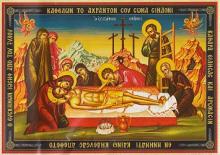
On this day we celebrate the burial of Christ and His descent into Hades. At Matins, usually held on Friday evening, the service begins with the 'Praises' (Ed. note - also called Lamentations) sung before the Epitaphion in the center of the church. The predominant note at this service is not so much one of mourning as of watchful expectation. For the time being God observes a Sabbath rest in the tomb, but we look forward to the moment when He will rise again, bringing new life and recreating the world:
At the end of the service, all go with the Epitaphion around the outside of the church, singing 'Holy God...', exactly as they would at a funeral. And yet this is not in fact a funeral procession at all. God had died on the Cross, and yet He is not dead. he who died, the Word of God, is the Life Himself, holy and immortal; and our procession through the night signifies that He is now proceeding through the darkness of Hades, announcing to Adam and to all the dead His coming Resurrection, in which they are also called to share.
In the morning and early afternoon of Holy Saturday there follow Vespers and the Liturgy of Saint Basil. Originally this service began later, in the evening, and continued into the early hours of Pascha Sunday morning; but now it has been moved back, and its place taken by the existing midnight service of Paschal Matins, with the Canon of St. John of Damascus, 'This is the Day of Resurrection...', followed by the Liturgy of Saint John Chrysosotom. The more ancient vigil service, now served on Saturday morning, has a strongly baptismal character, reflecting the period when this sacrament was administered on Pascha night. The texts at Vespers are dominated by the three connected themes of Passover, Resurrection, and baptismal initiation. Of the fifteen Old Testament readings - constituting the final stage in the teaching imparted to the catechumens before they were baptized - readings 3, 5, 6, and 10 refer directly or symbolically to the Passover; readings 4, 7, 8, 12, and 15 refer to the Resurrection; and readings 4, 6 14, and 15 refer symbolically to Baptism. The baptismal character of the Holy Saturday office is likewise apparent in the chant sung in place of the Trisagion, 'As many as have been baptized into Christ...', and in the choice of the Epistle reading (Rom. 6:3-11). With the verse following the Epistle, 'Arise, O God...', the celebration of the Resurrection has already begun.
On Holy Saturday evening the people gradually reassemble in the darkened church while the Acts of the Apostles are read and then the Midnight Office is sung. As twelve o'clock approaches, the lights in the body of the church are extinguished. All wait in silence for the moment when the priest will come out from the sanctuary with the burning candle that symbolizes the light of the risen Christ. So the period of the Lenten Triodion closes in a spirit of intense and eager expectation. 'Surely I am coming quickly', the Savior says to us (Rev. 22:20), and in our hearts we make ready to reply to the risen Christ: 'Amen, Come, Lord Jesus!'
- From The Lenten Triodion, "The Meaning of the Great Fast", Metropolitan Kallistos (Ware)
